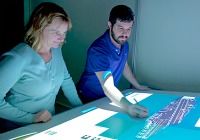
Crew members aboard U.S. aircraft carriers still use a scale model with miniature airplanes to keep track of all the activity on the deck, but the Massachusetts Institute of Technology is developing a computerized system to simplify that process. Prof. Mary Cummings and her students in the Humans and Automation Lab have designed a “deck operations course of action planner” that can track flight data and create new deck operation schedules. The team created a display that shows a map of the carrier deck. Crew, vehicles, and aircraft would be outfitted with sensor tags that transmit their position to the display. Side panels show the type and number of aircraft in line to land and launch, and flight schedules. The team recently successfully demonstrated the system for the Office of Naval Research, which is funding the five-year project.
The system is not meant to be fully automated, but to provide suggestions that a human operator can accept or change. For example, a deck handler may see on the schedule that a pilot with a history of shaky landings is due to land. Based on this anecdotal knowledge, the handler may choose to move the plane up in the landing schedule. “If he botches it [the first time], we have enough time to give him another try,” said student Jason Ryan. “That’s something that’s hard to program into systems, but it’s something that a human can look at and understand.” The planner could be especially helpful for managing the growing fleet of unmanned aerial vehicles, said Mark Steinberg, program officer for the ONR. “The long-term goal is, we would like to have unmanned autonomous systems on board, which require special procedures where you’d have to clear everything off the deck and implement certain safety measures,” Steinberg said. “We would like to make this as easy as possible as we introduce more and more UAVs onto carriers.”


































